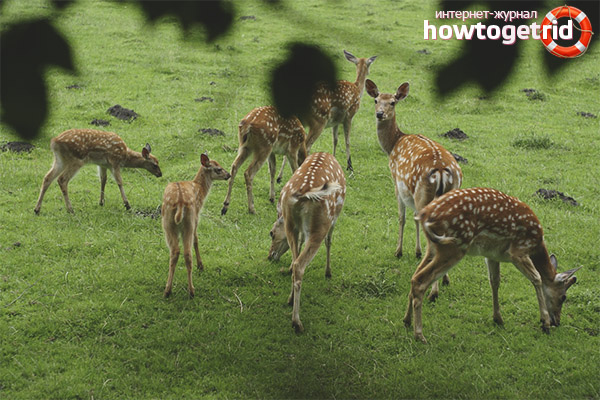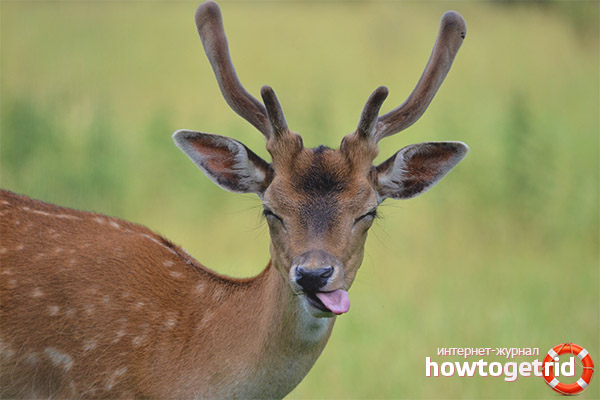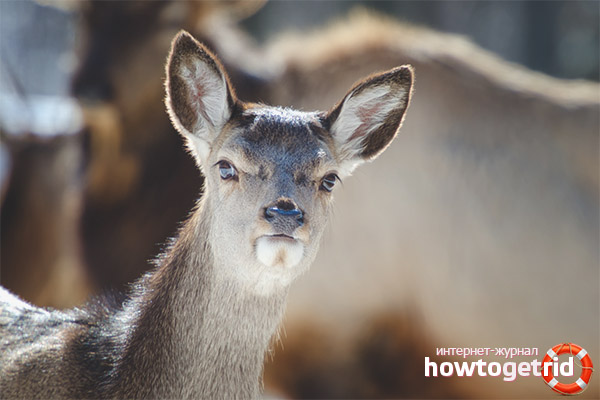The content of the article
You can find many legends, legends and rumors ο such an elegant animal as a doe. Often the image of this beautiful deer is inextricably linked with female qualities: harmony, grace, harmony. At the same time, there is something mysterious in this image, some shade of the demonic. But in reality, what is a doe? Affectionate and sensual, or dangerous and powerful?
Appearance
There are two varieties of fallow deer: European and Iranian. The first species is the most common, but it is believed that initially only Iranian fallow deer existed on earth. The dimensions of a deer that lives in Europe can reach 100 centimeters in height and 160 centimeters in length on average. The weight of an adult male reaches 105 kilograms, while females weigh about 65 kg. The animal has a not very long tail, on the head of the male there are weighty horns that acquire a spade-like appearance at the time of growing up.
Along with other varieties of deer, the size of the horns of a male fallow deer increases with his age. With the onset of April, the horns are discarded and over the next year again grow from small horns. The color of the body of a doe is seasonally dependent. In winter, the neck and head area of the animal has a brown tint, from the sides and back the doe is completely black, and the bottom is mainly gray.
But in the summer, doe becomes more attractive and beautiful: from the sides and back, the hair becomes lighter, decorated with graceful white spots, and the limbs and abdomen become almost white in color.
Often you can meet a completely black animal (the so-called melanists) or a completely white doe (albino). Since ancient times, such animals have been considered those who portend a variety of incidents and events.
Externally, the Iranian doe has no differences in comparison with the European species. We can only say that the males of this animal are slightly larger - the length of their body can reach a couple of meters. If we compare fallow deer with other varieties of deer, it can be noted that it has stronger and stronger muscles, the neck is more developed, and the legs are less long.
Habitat
From ancient times they were transported to Italy and Greece, a little later to the territory of Britain and Europe. Until the sixteenth century, these deer lived in Poland, Latvia, in the west of Belarus. But at present, it is unlikely that they will be able to meet these animals.
Over time, doe came to the north and south of America, to Japan and Chile, Madagascar and Australia. However, by now, the doe has completely disappeared from many points on the world map.
Currently, Iranian fallow deer is listed in the Red Book - the number of the species is literally several hundred animals. Things are slightly better with the European doe, the number of goals reaches about a couple of hundred thousand. Doe is an animal that mainly lives in a wooded area, where there are many open glades, lawns and thickets of shrubs. However, having fallen into unfamiliar conditions, this deer can quickly adapt to them.
Character and lifestyle

In the summer, doe usually lives alone or organizes a few groups. Fledglings adhere to the mother, without departing from her over long distances.These animals are most active in the morning or evening, when the air is cooler. It was at that time that fallow deer begin to graze and visit places of watering.
When the hot hours come, these animals prefer to relax on spacious loungers located in a shady area. Typically, such places doe is found in thickets of shrubs near various water bodies. There they have the opportunity not only to escape from the heat, but also to avoid the accumulation of vile.
Doe is not shy and timid. Compared to other representatives of the deer, the doe is not so timid and cautious. If these deer live in the park near the person, they can take food from human hands and become partly tame.
In anticipation of winter, deer usually organize large and numerous herds, the male and female in which they move together. It was at this time that one could see the most spectacular and spectacular ritual inherent in deer - tournaments, fights and further weddings.
Fighting for the female’s attention, animals can break their opponent’s neck, and in some cases, themselves. This fully indicates the fierceness of such battles. It also happens that both males die if their horns tightly mate.
After the female and male converge, and the doe begins to bear offspring, her chosen one moves away and prefers to live alone. But with the onset of severe cold weather, males again gather in a certain group to winter the hard season.
Doe very rarely leaves favorite places. These animals prefer not to leave the borders of their territory. Their daily route is monotonous, runs through the same places. In addition, these deer do not have good adaptability to movement in the snow due to the small size of the limbs.
However, due to the excellent sense of smell, a doe can easily find food for itself under the snow deposits, which includes moss, plant roots. Also, this deer has a keen ear, which compensates for not the strongest vision. Despite this, the animal can easily hear a person at a distance of more than 300 meters. And when the fallow deer is in danger, they usually can successfully escape. The length of a fallow deer doe reaches a couple of meters. In addition, such animals swim great, but enter the water only in case of emergency.
Doe feeding
Doe refers to ruminants that are herbivores. Their diet includes plant foods: tree bark, fragments of leaves, branches, shrubs and grass.
These deer can eat a variety of seasonal plants. In the spring, their favorite treats are shoots of mountain ash, pine or maple, snowdrops and anemone. In the summer, they are happy to eat chestnuts, a variety of berries and cereals, sedge, mushrooms found and acorns or chestnuts that have fallen from the trees. With the onset of cold weather, the diet consists of branches and tree bark. In addition, doe tries to find a terrain with soil that is rich in various salts. This is necessary to replenish mineral reserves.
Those people and organizations that have a certain interest in expanding the population of these animals in a particular area usually form salt licks for them, create artificial feeders that are filled with cereals and hay. Also sometimes whole glades are laid on which plants that are part of the fallow deer diet grow.
Doe lifespan and breeding
Around September, these animals begin the rutting phase, which continues until the very end of autumn. Females prefer to stay away from fights between males, which, in turn, are extremely affected during these months, not only from severe injuries, but also from malnutrition.
They significantly lose weight, since all the male’s energy is directed only to manage to cover the maximum number of females. They are accepted to shout loudly, informing all surrounding animals ο their own right to own a specific territory and those females that live there.
The male becomes more mobile, aggressive and extremely excited. In addition, their ordinary timidity and caution disappear. When several powerful and adult males enter the herd of females, they immediately drive out more timid teenagers from there. The yearlings, in turn, throughout the rut live in some distance to return to their mothers in the winter. During the season, the male on average covers about 8 females.
The female carries offspring for about eight months, and by May one baby is usually born. Over the next 4 months, he eats mother's milk, over time, switching to foods inherent in an adult. By a couple of years, a young deer reaches adulthood. On average, doe live for about 28 years.
Video: doe (Dama dama)











Submit